Contents


The mulberry has been known since time immemorial – the first paper was made from its wood, the production of natural silk is associated with its leaves, and delicious berries, wines and desserts made from them are now known all over the world. There are several cultivated species: white mulberry is grown for the berries and leaves that go to feed the silkworm, black mulberry is cultivated throughout Europe for the delicious berries and decorative qualities of the tree itself, its leaves turned out to be too coarse for the silkworm, the red mulberry is also valued for its fruits and appearance. In America, there grows a mulberry tree with inedible fruits, in which only wood is valued.
Description
Iran is considered the birthplace of black mulberry, a shrub and a tree that belong to the Mulberry family are known. A tree in the wild can grow up to 35 m tall, so its growth is usually limited in the garden. It belongs to deciduous crops, that is, every spring young green leaves grow from the buds. By the middle of summer, they can be quite large – up to 25 cm long and 15 cm wide, and in the fall, almost all varieties delight with a beautiful change of color, the trees turn yellow and majestically crumble. Trees live for several centuries, specimens are known for 200, 300 years and even more, they begin to bear fruit after reaching 5-8 years, some varieties even later, and grafted plants bear fruit already in the third year.
Among the mulberries, there are monoecious – they have male and female flowers located side by side, and dioecious – with flowers of only one sex. Flowers are pollinated by the wind, one monoecious tree is enough to provide a family with delicious sweet berries, since a 10-year-old tree can produce up to 100 kg of fruit per season.
Their fruit is a drupe, what we incorrectly call a berry is actually tiny drupes tightly sitting on an overgrown stalk. Such a false berry in black mulberry is usually very dark, purple or red to black, but this is not why they call black mulberry, because white mulberry fruits are also not only white, but also black. White and black mulberries differ in the color of the bark – in white it is light, light brown, or yellowish, while in black it is much darker, sometimes with a red tint, all covered with a lace of small cracks. And the fruits (the so-called berries) are small, about 1 cm long, but in cultivated varieties usually 2,5 to 5,5 cm.
The fruits are not only tasty, sweet, sometimes sour, juicy, with amazingly resistant ink, stains from which are difficult to remove from the fabric. They contain many useful substances – vitamins A, C, B1, B6, K, E, PP, carotene, macro- and microelements, sugars and acids, essential oils. Thanks to such a rich composition, they have a beneficial effect on the human body, help strengthen immunity, correct impaired metabolism, and restore the functioning of many internal organs, disturbed by diseases. Traditional medicine has been using all parts of the plant for centuries to improve human health, to alleviate many conditions.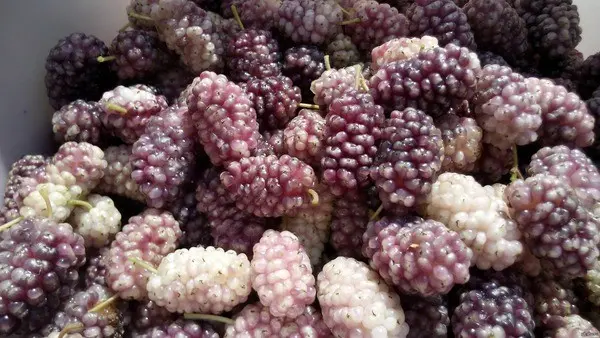 Berries are eaten fresh, but they are stored for no more than three days, so many delicious desserts are prepared from them, dried, canned, wine and even vodka are made. The fruits ripen unevenly, next to the black ripe berries there can be red of different shades (of different degrees of maturity) or even just emerging ones. Ripening sometimes stretches for 1,5 – 2 months – from the end of June to August. Overripe fruits fall off. The crop is harvested by shaking, a film or cloth is spread under the tree, the branches are shaken, and then the crop is poured from the film into a more suitable container.
Berries are eaten fresh, but they are stored for no more than three days, so many delicious desserts are prepared from them, dried, canned, wine and even vodka are made. The fruits ripen unevenly, next to the black ripe berries there can be red of different shades (of different degrees of maturity) or even just emerging ones. Ripening sometimes stretches for 1,5 – 2 months – from the end of June to August. Overripe fruits fall off. The crop is harvested by shaking, a film or cloth is spread under the tree, the branches are shaken, and then the crop is poured from the film into a more suitable container.
Video “Features of growing mulberries”
From the presented video you will learn how to grow mulberries.
Reproduction
Mulberries are propagated using seeds, root shoots, cuttings and layering. Seeds germinate perfectly, for this they must undergo stratification, they are sown before winter in the garden, then watered, mulched. During spring sowing, the seeds are prepared – they are kept in the refrigerator for two months, only once a week they are taken out to a warm room for several hours.  They sprout well, then they are looked after like ordinary seedlings, excellent grafting material will grow from these sprouts. Unfortunately, the seeds do not guarantee that the plant will retain the characteristics of the mother tree, it is even impossible to know in advance whether a monoecious or dioecious plant will turn out, so the desired variety is grafted onto them, and such a plant will grow healthy and begin to bear fruit earlier than it appeared in another way.
They sprout well, then they are looked after like ordinary seedlings, excellent grafting material will grow from these sprouts. Unfortunately, the seeds do not guarantee that the plant will retain the characteristics of the mother tree, it is even impossible to know in advance whether a monoecious or dioecious plant will turn out, so the desired variety is grafted onto them, and such a plant will grow healthy and begin to bear fruit earlier than it appeared in another way.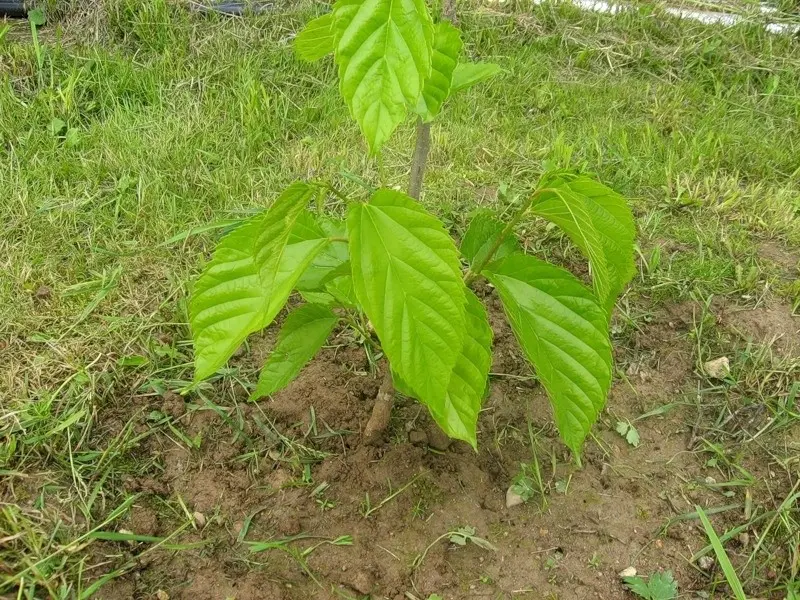
Root growth appears under almost every tree, such a sprout can be simply separated, trying not to damage the roots, and transplanted to a new place, but such plants also do not retain the features of the mother tree – planting such a seedling in your area is the same as buying a cat in bag.
For cuttings, young or semi-lignified shoots are taken, but they take root very poorly, this can be done, but an artificial fog installation is required – they need so much moisture. Usually summer residents do not do this, it is much easier to graft a branch from a good tree onto seedlings obtained from seeds or onto a root process.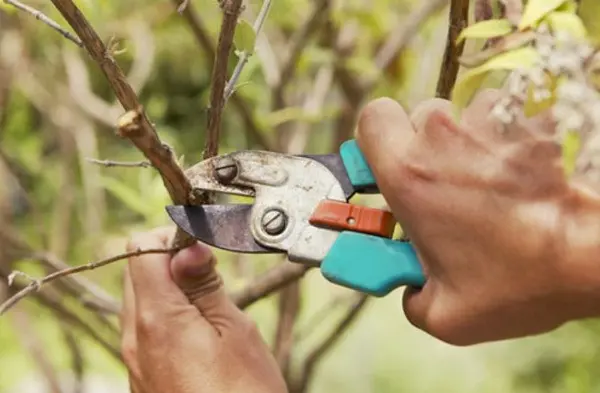
It is easy to get layering from shrubs, tree branches are far from the ground, it is simply physically impossible to bend them down, but seedlings obtained by rooting layering most often grow into a strong tree, retain all the characteristics of the mother plant variety. You can cut off a thick branch in the spring; during the summer, flexible young branches will grow on the stump, which will easily bend down to the ground. In the spring of next year, you need to take a branch, bend it to the ground, in a place that can be buried, remove the bark along the ring around the entire branch for a couple of centimeters, pin it to the ground, bury it, water it, and hill it up until the end of the growing season. By autumn, it will take root, you can cut it off from the mother tree and plant it in a permanent place of growth.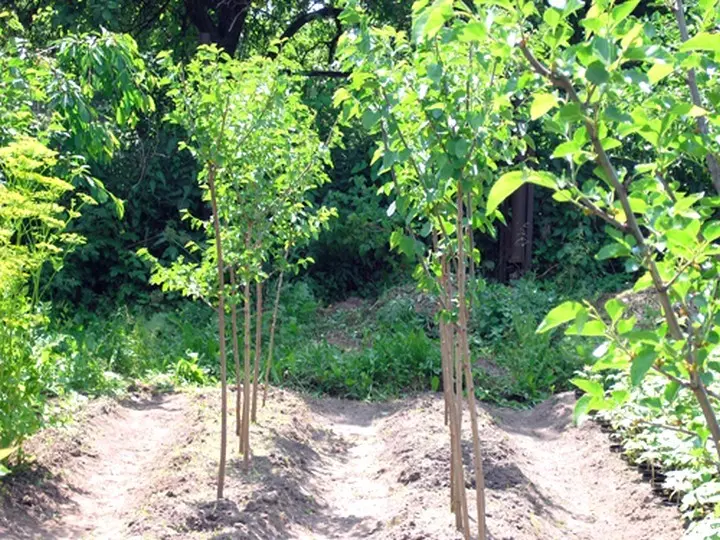
Some gardeners do cuttings in one season, but this will have to deliver the earth to the branch, since it cannot get to the ground. It is necessary to make a plastic sleeve – a long bag with a cut off bottom, put it on the selected branch, a few centimeters below the bare spot (the bark is first removed on the branch along the ring), tie it tightly. Then, moist loose soil is poured into this resulting package, the bare place of the branch is fixed in it, tying the package above this place. It is advisable to cover this branch of the garden so that direct sunlight does not fall on it, and by autumn the branch should take root, then it can be cut off and planted as an independent seedling.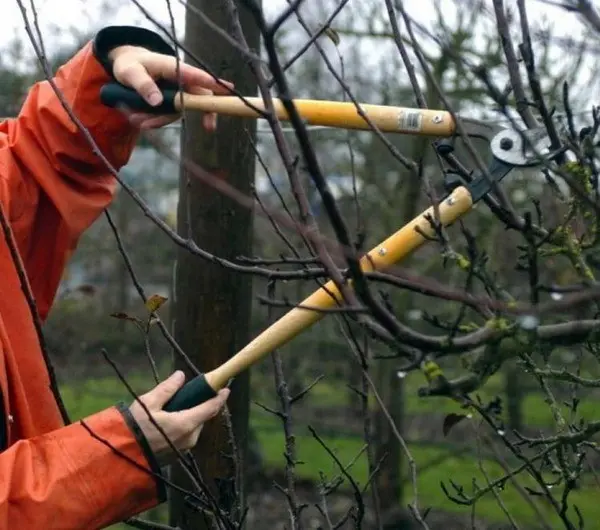
Mulberry grafts well, so when propagating, it is best to graft the desired variety on a seedling obtained in any way, this will speed up the onset of fruiting.
Features of care
When a new tree is planted in the garden, it is usually watered, fed, protected from pests, weeded and loosened near the trunk circle, and also cut once or twice a year. Mulberry needs the same care, but when settling black mulberry in your garden, you need to know some of the nuances of caring for this particular type of mulberry tree. So, you can water and feed it only in spring and at the very beginning of summer, in mid-June all these activities are stopped, only in this case the tree will winter well. Watering should be restrained if there is no rain at all, and fertilizing with mineral fertilizers should be done after 4 or 5 years of the tree’s life.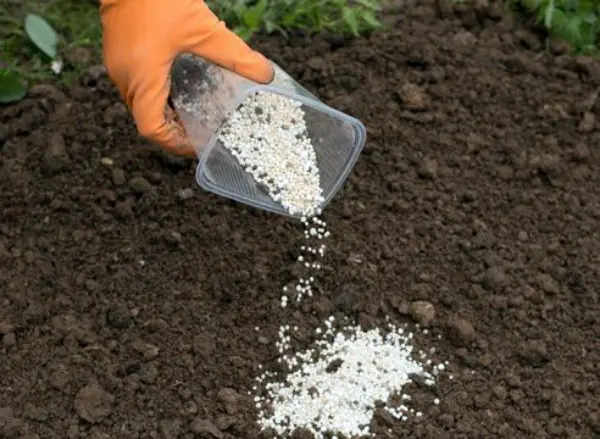 An adult tree can be watered more (in spring) and fertilizers can be added if the state of greenery shows the need for these actions. The fact is that the black variety of mulberry tolerates cold worst of all, it is used to growing in a warm climate with long summers and mild winters, if you give it a lot of water and fertilizer, it will not prepare for wintering, it will try to extend its growing season, which means that with the advent of frost can freeze.
An adult tree can be watered more (in spring) and fertilizers can be added if the state of greenery shows the need for these actions. The fact is that the black variety of mulberry tolerates cold worst of all, it is used to growing in a warm climate with long summers and mild winters, if you give it a lot of water and fertilizer, it will not prepare for wintering, it will try to extend its growing season, which means that with the advent of frost can freeze.
When planting a seedling, the pit must be filled only with soil without additional fertilizers. If the soil is completely depleted, you need to prepare it in advance, dig a deep area of 1 square meter, add peat if the soil is too heavy or compost (humus) if sandy and infertile.
It is better to do this in the fall for spring planting or in the middle of summer for autumn planting. Then you just need to dig a hole of suitable size, drive a strong stake into its bottom, lower the seedling, straighten all the roots, carefully sprinkle them with earth, then fill the hole completely, press down the earth around the trunk, tie the seedling to the stake, pour it with two buckets of water, mulch the trunk a circle. Mulberry roots are very fragile, you need to make sure that they are not damaged during planting, and then dig less around the tree, loosen the ground very carefully. Experts say that having received a lot of fertilizer, the seedling will fatten, which means it will not have time to prepare for winter.
Young mulberry trees grow quickly, you need to immediately decide on the growth to which you will allow it to grow, boldly cut it off, forming a crown, from the very first year. Bushes are planted at a distance of 1,5 – 2 m and rows are made every 3 m. But a tree must be planted 5 m from other large trees, otherwise it will not have enough space. And the mulberry tree loves a lot of sun, it is only desirable to protect it from the north wind.
In the spring, formative pruning is done. Usually they leave a clean trunk up to 1,5 m, removing all side shoots below this mark, and then they form a crown skeleton, most often spherical. It is possible to form a low tree, like a dwarf apple tree, for this, the central conductor is cut off at the selected height, up to 8-10 skeletal branches are left, adjusting their length. If the tree is allowed to grow up to 2 – 3 meters, then the central conductor is cut off after this mark, and the skeletal branches are cut off as necessary to limit the growth of the crown. In weeping varieties, they usually only monitor the length of the shoots and thin out the crown. During autumn pruning, all branches damaged or growing in the middle of the crown are removed, thinning is also done in the spring. It is necessary to ensure that the crown does not become too thick, the sun must penetrate inside the tree, otherwise its lack will affect the ripening of the fruit.
Mulberry very rarely gets sick, but it can be affected by bacteriosis, cylindrosporiosis, curly small-leaved, powdery mildew, root rot. There are special preparations that will surely save you from each of these misfortunes, but it is better to take preventive measures – to prevent thickening of the crown, excessive moisture, and excess nitrogen fertilizers. Fallen leaves are best removed from under the tree, to prevent weeds from growing.
If Khrushchev and Medvedka settled on the site, then mulberry roots may suffer from them, but the American white butterfly, spider mite, Comstock worm can damage the greens. Pests settle in the cracks of the bark or among the leaves, breed offspring there, which feed on buds, foliage or tree sap. In order to notice their appearance in time and start a fight, you need to carefully examine the tree, you can often collect nests (butterflies), destroy the larvae in time, or use special traps that are arranged on the tree. Black mulberry very rarely suffers from diseases and pests, but you need to be careful to notice troubles early if they do occur. But the birds always try to take a tasty harvest before the owners, often they have to save the berries from them.
Varieties of varieties
Breeding work on mulberry varieties is ongoing, many teams are trying to make black mulberry more frost-resistant. The variety of the Poltava breeder “Shelley No. 150” is very popular. It is distinguished by large sweet black berries weighing 4 to 6 g each (5,5 cm long). The berries begin to ripen already at the end of May, all June you can eat them fresh.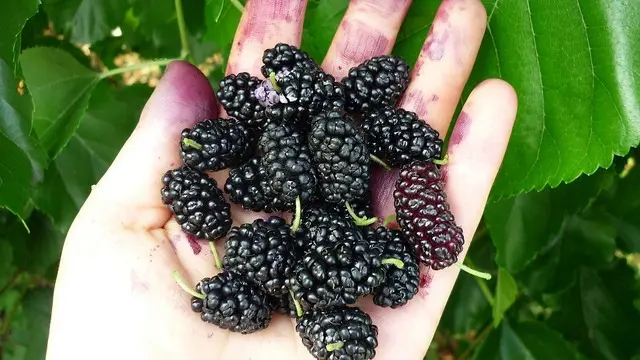
Among the large-fruited varieties, “Black Prince”, “Black Pearl” are distinguished. In July, quite large (up to 5 cm long) berries of the Nadezhda variety also ripen, they have a noticeable sourness in taste. Trees grow up to 10 meters, they are afraid of frost. In the Moscow region, the varieties “Staromoskovskaya”, “Plodovaya – 4”, “Royal” are grown. They do not have such large fruits, but one adult tree can produce from 60 to 90 kg of sweet healthy berries.
Video “The subtleties of caring for a mulberry tree”
From the presented video you will learn about all the intricacies of caring for mulberries.









